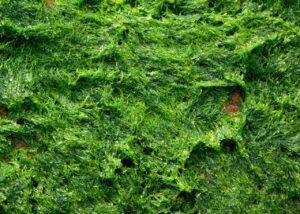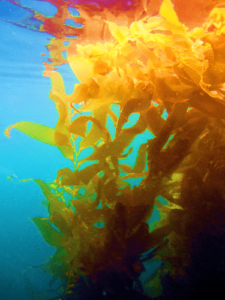Introduction
Algae are photosynthetic eukaryotes with one or more cells that live in watery environments. They serve as the foundation of aquatic food chains that supply nutrients to a variety of aquatic herbivores. An algal bloom occurs when the population of algae suddenly increases, usually as a result of changed environmental conditions. A bloom of algae resembles foam or scum floating over the water. Some algal blooms emit a foul stench as a result of the overgrowth of bacteria. A distinguishing characteristic of an algal bloom is the physical colouring of the water.
What is an Algal Bloom?
Algal blooms occur either in freshwater or marine water systems, resulting in the rapid growth of algae. As a result of the pigments, water appears red, brown, reddish-brown, or green. The size of algae may vary from unicellular organisms to macroscopic multicellular organisms. In contrast to multicellular entities, algal blooms are characterised by microscopic organisms. In stagnant water, an algal mat forms when the population size is elevated. As a result, aquatic organisms have less oxygen available to them.

Improving your Science concepts. Study Science Lesson for classes 6th, 7th, and 8th.
What are the causes of Algal Bloom?
Climate:
- During the time of summer, ponds and lakes experience a marked increase in temperature and light intensity, both of which may lead to algal blooms.
- The stillness of stagnant water, such as ponds and lakes, causes the top layers of water to heat up while the deeper layers of water remain relatively cool.
- As a result of low wind speeds, surface water tends to be still, allowing thermal stratification to occur.
- Extended drought due to poor rainfall and reduced water flow into freshwater systems make them stagnant. This is an added advantage for algae to multiply their numbers.
Nutrient load:
- Dissolved minerals provide nutrients to aquatic species. When water is overloaded with nutrients (excess nitrogen and phosphorus), algae are fertilized and grow rapidly. The process of loading nutrients into the water body is known as eutrophication.
- Nitrogen and phosphorus-rich fertilizers are sprayed on farmlands and crops. Water streams drain fertilizer into lakes and reservoirs after heavy rains. Water bodies are polluted by urban wastes carried by stormwater runoff.
- Algal blooms on shorelines are caused by nutrients carried by rivers and deposited into oceans.
United effect:
- Algal bloom cannot be solely caused by nutrient enrichment. Several factors must come together to produce an unusual environmental condition for algae to bloom.
- It is possible for algae not to bloom in muddy ponds, even though the water is nutrient-rich, warm, and stagnant.
- Due to the turbidity of muddy waters, and lack of sunlight needed for photosynthesis they cannot grow.
Importance of Algal Bloom
- Algal blooms render water unsafe for consumption by both animals and humans.
- Some algal blooms have a slimy appearance and a bad odour.
- They cause serious economic losses by making the water unfit for leisure activities like swimming, boating, and fishing.
- In the water, some algal blooms release poisons or compounds that can seriously ill human beings. They are referred to as harmful algal blooms (HAB).
Effects of Algal Bloom
Effect on the ecosystem:
- Algal bloom can be thought of as a disturbance to the natural environment because of its impact on it. Any species’ population fluctuations can have a direct or indirect impact on other creatures living in the particular ecosystem. A single algae species’ overpopulation stunts the development of other organisms, which has clear implications for the food chain.
- Dead zone: The lifespan of algae is brief. After the life cycle is complete, a fast rise in population causes dead biomass to accumulate. It creates a need for extensive breakdown. Dissolved oxygen is depleted by decomposers, which reduces its availability to other life forms. Aquatic organisms have a difficult time surviving and exhibit significant mortality in a habitat with little dissolved oxygen. A dead zone results from this. Dead zones result in significant economic losses for the fishing and shellfish industries.
- The dead, rotting algae float as floating particles that block fish gills and kill them.
- When algae create poisons that are detrimental to people and other living things, then they are known as harmful algal bloom (HAB). Direct contact with HAB can result in a deadly disease and severe sickness, fever, diarrhea, and skin rashes.
- Water that has algal blooms is unsafe for drinking and other recreational uses.
How does Algal Bloom affect the Quality of Water?
- Depending on the species, algal blooms can look like scum, froth, or paint.
- They could tint the water and emit a foul, pungent stench.
- Algal pigments give water its reddish, pinkish, yellowish, brownish, or golden appearance.
- Water becomes unsafe for drinking when algae develop. Drinking water that contains dangerous algal blooms poses serious health hazards.
- The neurological system, liver, and gastroenterological system are all negatively impacted by toxins.
- Toxins in HAB water cannot be eliminated by boiling or cooking.
Summary
Algal blooms occur either in freshwater or marine water systems, resulting in the rapid growth of algae. During the summer, ponds and lakes experience a marked increase in temperature and light intensity, both of which may lead to algal blooms. Algae are fertilized and grow rapidly when water is overloaded with nutrients (excess nitrogen and phosphorus). Algal blooms render water unsafe for consumption by both animals and humans. The dead, rotting algae float as floating particles that block fish gills and kill them.
Frequently Asked Questions
1.How Long does an Algal Bloom Last?
Ans. Algal blooms are a transient phenomenon that continues for a maximum of five months. While apparent algal blooms fade away as a result of cleaning and restoration efforts, toxins cannot disappear unless the water goes through an effective treatment procedure.
2. How can Algal blooms be Stopped in Lakes and Reservoirs?
Ans. Aerators are installed in lakes to prevent immobility. Aerators continuously circulate water to avoid stagnation since motionless water causes thermal stratification.
3. Describe Red Tide.
Ans. Algal bloom in oceans is frequently referred to as “red tide.” When ocean waters are physically discoloured, it is more acceptable. Red tides are not always dangerous algal blooms.

